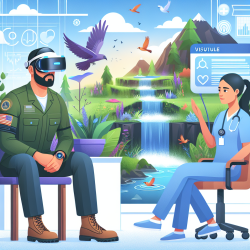Introduction to Virtual Reality in PTSD Treatment
The integration of Virtual Reality (VR) into clinical settings has been a game-changer, particularly in the treatment of posttraumatic stress disorder (PTSD). The recent research article "Clinical Virtual Reality tools to advance the prevention, assessment, and treatment of PTSD" highlights how VR can be used as a clinical tool to address the assessment, prevention, and treatment of PTSD. This blog will explore how practitioners can leverage these findings to enhance their therapeutic approaches.
Understanding VR's Role in PTSD Therapy
VR technology offers a unique way to immerse patients in simulations of trauma-relevant environments. This approach allows clinicians to control the emotional intensity of the scenes, customizing the pace and relevance of the exposure for each patient. This method, known as Virtual Reality Exposure Therapy (VRET), helps circumvent the natural avoidance tendencies of PTSD patients by directly delivering multi-sensory and context-relevant cues.
Benefits of VR in PTSD Treatment
- Controlled Environment: VR provides a consistent and controlled environment for exposure therapy, allowing for precise documentation of the sensory stimuli.
- Enhanced Engagement: Patients often find VR more engaging than traditional therapy methods, which can lead to better outcomes.
- Overcoming Avoidance: VR helps patients confront their trauma in a safe, controlled setting, which is crucial for effective therapy.
Expanding VR Applications
The research also discusses the development of virtual human agent systems, which can serve as virtual patients for training new clinicians. These systems can support anonymous access to trauma-relevant behavioral healthcare information and act as clinical interviewers capable of automated behavior analysis to infer psychological states.
Encouraging Further Research
While the current findings are promising, further research is needed to explore the full potential of VR in PTSD treatment. Practitioners are encouraged to stay informed about the latest developments in VR technology and consider participating in research studies to contribute to this evolving field.
Conclusion
VR is not just a futuristic concept but a practical tool that is transforming the landscape of PTSD treatment. By incorporating VR into therapeutic practices, clinicians can offer more effective and engaging treatments for their patients.
To read the original research paper, please follow this link: Clinical Virtual Reality tools to advance the prevention, assessment, and treatment of PTSD.










